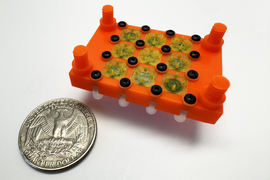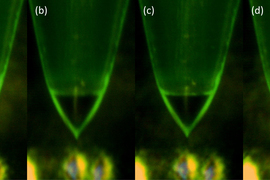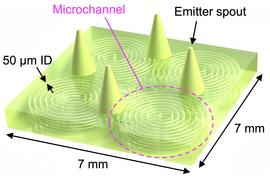An electrospray engine applies an electric field to a conductive liquid, generating a high-speed jet of tiny droplets that can propel a spacecraft. These miniature engines are ideal for small satellites called CubeSats that are often used in academic research.
Since electrospray engines utilize propellant more efficiently than the powerful, chemical rockets used on the launchpad, they are better suited for precise, in-orbit maneuvers. The thrust generated by an electrospray emitter is tiny, so electrospray engines typically use an array of emitters that are uniformly operated in parallel.
However, these multiplexed electrospray thrusters are typically made via expensive and time-consuming semiconductor cleanroom fabrication, which limits who can manufacture them and how the devices can be applied.
To help break down barriers to space research, MIT engineers have demonstrated the first fully 3D-printed, droplet-emitting electrospray engine. Their device, which can be produced rapidly and for a fraction of the cost of traditional thrusters, uses commercially accessible 3D printing materials and techniques. The devices could even be fully made in orbit, as 3D printing is compatible with in-space manufacturing.
By developing a modular process that combines two 3D printing methods, the researchers overcame the challenges involved in fabricating a complex device comprised of macroscale and microscale components that must work together seamlessly.
Their proof-of-concept thruster comprises 32 electrospray emitters that operate together, generating a stable and uniform flow of propellant. The 3D-printed device generated as much or more thrust than existing droplet-emitting electrospray engines. With this technology, astronauts might quickly print an engine for a satellite without needing to wait for one to be sent up from Earth.
“Using semiconductor manufacturing doesn’t match up with the idea of low-cost access to space. We want to democratize space hardware. In this work, we are proposing a way to make high-performance hardware with manufacturing techniques that are available to more players,” says Luis Fernando Velásquez-García, a principal research scientist in MIT’s Microsystems Technology Laboratories (MTL) and senior author of a paper describing the thrusters, which appears in Advanced Science.
He is joined on the paper by lead author Hyeonseok Kim, an MIT graduate student in mechanical engineering.
A modular approach
An electrospray engine has a reservoir of propellant that flows through microfluidic channels to a series of emitters. An electrostatic field is applied at the tip of each emitter, triggering an electrohydrodynamic effect that shapes the free surface of the liquid into a cone-shaped meniscus that ejects a stream of high-speed charged droplets from its apex, producing thrust.
The emitter tips need to be as sharp as possible to attain the electrohydrodynamic ejection of propellant at a low voltage. The device also requires a complex hydraulic system to store and regulate the flow of liquid, efficiently shuttling propellant through microfluidic channels.
The emitter array is composed of eight emitter modules. Each emitter module contains an array of four individual emitters that must work in unison, forming a larger system of interconnected modules.
“Using a one-size-fits-all fabrication approach doesn’t work because these subsystems are at different scales. Our key insight was to blend additive manufacturing methods to achieve the desired outcomes, then come up with a way to interface everything so the parts work together as efficiently as possible,” Velásquez-García says.
To accomplish this, the researchers utilized two different types of vat photo polymerization printing (VPP). VPP involves shining light onto a photosensitive resin, which solidifies to form 3D structures with smooth, high-resolution features.
The researchers fabricated the emitter modules using a VPP method called two-photon printing. This technique utilizes a highly focused laser beam to solidify resin in a precisely defined area, building a 3D structure one tiny brick, or voxel, at a time. This level of detail enabled them to produce extremely sharp emitter tips and narrow, uniform capillaries to carry propellant.
The emitter modules are fitted into a rectangular casing called a manifold block, which holds each in place and supplies the emitters with propellant. The manifold block also integrates the emitter modules with the extractor electrode that triggers propellant ejection from the emitter tips when a suitable voltage is applied. Fabricating the larger manifold block using two-photon printing would be infeasible because of the method’s low throughput and limited printing volume.
Instead, the researchers used a technique called digital light processing, which utilizes a chip-sized projector to shine light into the resin, solidifying one layer of the 3D structure at a time.
“Each technology works very well at a certain scale. Combining them, so they work together to produce one device, lets us take the best of each method,” Velásquez-García says.
Propelling performance
But 3D printing the electrospray engine components is only half the battle. The researchers also conducted chemical experiments to ensure the printing materials were compatible with the conductive liquid propellant. If not, the propellant might corrode the engine or cause it to crack, which is undesirable for hardware meant for long-term operation with little to no maintenance.
They also developed a method to clamp the separate parts together in a way that avoids misalignments which could hamper performance and ensures the device remains watertight.
In the end, their 3D-printed prototype was able to generate thrust more efficiently than larger, more expensive chemical rockets and outperformed existing droplet electrospray engines.
The researchers also investigated how adjusting the pressure of propellant and modulating the voltage applied to the engine affected the flow of droplets. Surprisingly, they achieved a wider range of thrust by modulating the voltage. This could eliminate the need for a complex network of pipes, valves, or pressure signals to regulate the flow of liquid, leading to a lighter, cheaper electrospray thruster that is also more efficient.
“We were able to show that a simpler thruster can achieve better results,” Velásquez-García says.
The researchers want to continue exploring the benefits of voltage modulation in future work. They also want to fabricate denser and larger arrays of emitter modules. In addition, they may explore the use of multiple electrodes to decouple the process of triggering of the electrohydrodynamic ejection of propellant from setting up the shape and speed of the emitted jet. In the long run, they also hope to demonstrate a CubeSat that utilizes a fully 3D-printed electrospray engine during its operation and deorbiting.
This research is funded, in part, by a MathWorks fellowship and the NewSat Project, and was carried out, in part, using MIT.nano facilities.
















